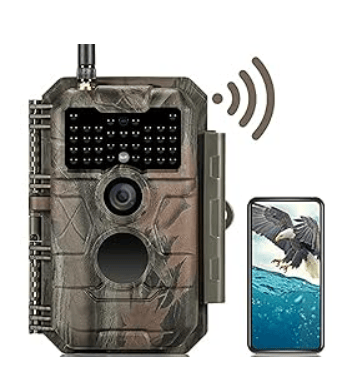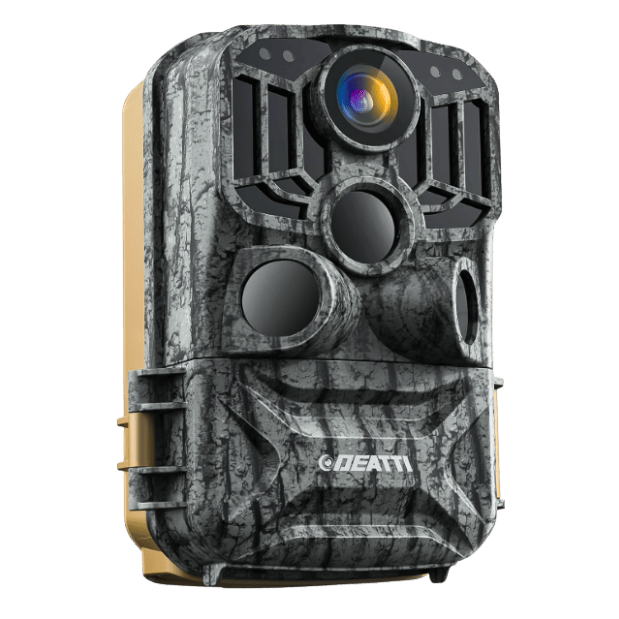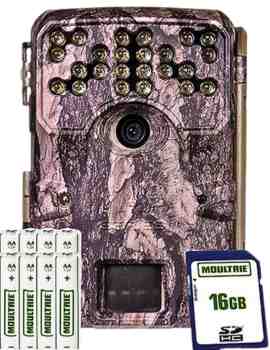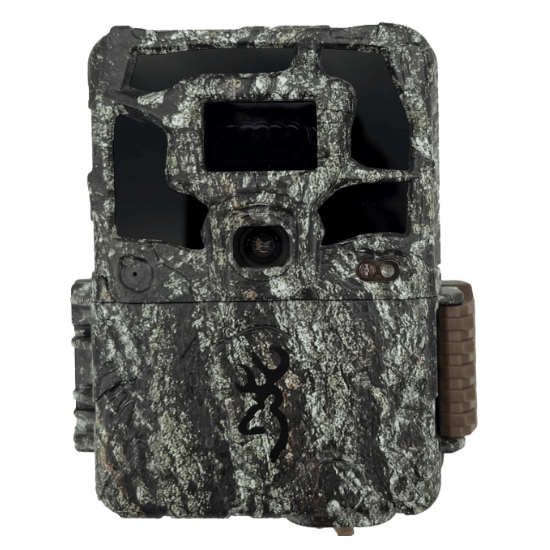2025’s Best Trail Cameras with WiFi: Wireless Features That WOW
Trail cameras with WiFi have become the latest craze in 2025, changing the game for wildlife monitoring and security. Imagine being able to access live footage from anywhere!
These cameras’ wireless connectivity provides unmatched access to real-time feeds, making them essential for both enthusiasts and researchers.
When exploring the world of WiFi trail cameras, it’s important to consider key features that match your specific needs. From high-resolution imaging to super-fast trigger speeds, these devices offer a wide range of options to improve your monitoring experience.
Whether you’re a wildlife lover or a security-minded homeowner, the advantages of WiFi trail cameras are clear.
In this guide, we’ll look at the best choices for 2025 that will leave you speechless. Get ready to be blown away by cutting-edge technology that takes wildlife monitoring to new heights.
How We Selected The 6 Best Trail Cameras With WiFi
To identify the best trail cameras with WiFi, we focused on several critical factors that affect your overall experience.
First, image and video quality were paramount, ensuring you get clear, detailed footage both day and night.
Next, we evaluated wireless connectivity features, including ease of setup, range, and whether the WiFi allows remote access or requires close proximity.
Battery life and power options were also considered since frequent battery changes can be a major inconvenience. Durability and weather resistance were essential for outdoor use, along with user-friendly apps and interfaces.
Finally, we examined customer feedback to highlight real-world performance and potential drawbacks you should be aware of.
1) GardePro E6
If you’re looking for trail cameras with wifi that actually make your life easier, the GardePro E6 is worth a close look. It’s designed to capture sharp 48MP photos and smooth 1296p videos, so whether you’re scouting wildlife, keeping an eye on your property, or just curious about what’s happening outside, you get clear, detailed shots.
The no glow night vision means you won’t spook animals or alert anyone nearby, and the waterproof build means it can handle whatever weather you throw at it.
What really stands out is the WiFi and Bluetooth connectivity paired with a free app, letting you check images and tweak settings right from your phone without trekking back to the camera.
It’s not perfect—the app and connection setup can be a bit fiddly—but once you get it going, it’s a solid companion for both casual nature watchers and serious outdoor enthusiasts.

What People Say
People appreciate how easy the GardePro E6 is to set up and use, especially the wireless features that let you manage the camera remotely. The image quality, both day and night, gets solid marks, and many find the no glow night vision a big plus for stealth.
Battery life can be a challenge if there’s a lot of activity, but rechargeable batteries help. Some users mention the app and WiFi connection process could be smoother, but overall, it’s a reliable option for capturing wildlife or securing property.
🗣️ Amazon Customer
This was the best bang for my buck when it came to trail cams. It has really done a great job of capturing wildlife in my yard. The only down side, is when there is a lot of activity, this thing chews though double A batteries (it takes 8!). But rechargeable AAs have easily solved that issue. Super easy to use and has lasted through some very hot and cold nights.
🗣️ David Lenweaver
I’m super impressed with the ease of setup and the image. Night vision is pretty much what I expected; I’m not terribly impressed with any camera on that mark. The Bluetooth and wireless setup is incredible, too. I planned on the connection taking forever, but it is a well-designed user interface and very, very friendly connection. You can review the images on your phone and delete them as well. It impressed me enough that I ordered one more so I can track wildlife passing through the property.
Rating: 4.0 (total: 4111+)
2) DEATTI DET-T4
If you want one of the best trail cameras with wifi that actually delivers, the DEATTI DET-T4 is a solid pick. It shoots stunning 48MP photos and crisp 4K videos, so you get clear shots whether it’s day or night. The motion-activated trigger is lightning fast at 0.1 seconds, which means you won’t miss those quick wildlife moments. Plus, the 120-degree wide-angle lens and three PIR sensors help cover a bigger area, so you catch more action.
What really makes this camera stand out is the WiFi and Bluetooth connectivity — you can check your photos and videos right on your phone without having to remove the SD card or trek back to the camera. It’s waterproof and built tough enough to handle outdoor conditions, making it great for everything from casual backyard wildlife watching to serious scouting trips.
The included 8 AA batteries and 32GB SD card mean you’re ready to go right out of the box. It’s not perfect — battery life can be shorter if you’re recording a lot of video — but overall, it’s a dependable, user-friendly option that brings wireless convenience to your outdoor adventures.

What People Say
Most folks appreciate how straightforward the DEATTI trail camera is to set up and use, especially enjoying the wireless features that let you access images and adjust settings from your phone.
The photo and video quality get high marks, with clear daytime shots and solid night vision. Battery life can be a bit short if you’re capturing lots of video, but the included batteries and SD card make it easy to get started.
Some users mention the Bluetooth range could be better, but overall, it’s a reliable and practical choice for anyone looking for the best trail cameras with wifi.
🗣️ Chelli
Great little camera for the price. Love that everything is included, card and batteries. Easy set-up, was viewing area wildlife within 20 minutes on my phone, which is great not having to remove card and then delete. Video quality is awesome. Battery life lasted a full month with it set on video at 10 seconds record time. Love that you can add password.
🗣️ Daniel A. Rivers
I live in the foothills of Colorado where we have mountain lions, bobcats, elk, moose, fox and many more natural inhabitants wandering around. We wanted a clear understanding of what is traveling across our property. This camera is an excellent tool for scouting these animals and identifying what is out there. The pictures are high definition images and everything can be set to the owners specifications. The camera is easy to set up, move, aim and retrieve images. A truly excellent trail camera well worth the cost.
Rating: 4.4 (total: 1217+)
3) Meidase P200
If you’re looking for trail cameras with wifi that make checking your shots easier, the Meidase P200 is worth a look. It captures sharp 48MP photos and smooth 1296p videos, so your wildlife footage looks great whether it’s day or night. The 0.1-second trigger speed means you won’t miss those quick moments, and the 100ft night vision with no glow tech keeps things discreet.
What’s really handy is the WiFi connection through its app, letting you view images and tweak settings right from your phone when you’re nearby. It’s waterproof and built to handle the outdoors, so it’s great for everything from casual backyard monitoring to more serious scouting.
Battery life can vary, especially if you’re recording lots of video, but using rechargeable batteries helps. Overall, it’s a solid, user-friendly option if you want wireless convenience without fuss.

What People Say
People like how easy it is to set up and use the Meidase P200, especially enjoying the ability to view photos and videos on their phone via WiFi without needing to remove the SD card. The image quality and night vision get good feedback, and the fast trigger speed helps capture quick wildlife moments. Some mention that the WiFi only works within a limited range and doesn’t connect to your home network, so remote access isn’t possible. Battery life can be hit or miss depending on usage, but rechargeable batteries seem to help. Overall, it’s seen as a dependable, straightforward trail camera with useful wireless features.
🗣️ JCH
Easy to set up. Have not used the built-in screen much, but I’ve reviewed many videos and pictures on my phone showing raccoons and possums digging up the yard. The first set of batteries lasted almost three months, which was impressive. Nighttime videos are well illuminated and clear. It’s been reliable through different weather conditions, and the WiFi connection to the app makes checking footage straightforward.
🗣️ John E.
This is my first trail camera and I’m really happy with it so far. I’ve had it running day and night for almost three weeks without issues. The 16MP photos and 1080p videos look good, and the camera handled cold, snow, and rain without a problem. Battery life dipped after two weeks but fresh batteries brought it back to full performance. The only downside is some false triggers from shadows and branches, but sorting through the photos isn’t too bad. Overall, a great camera for the price.
Rating: 4.1 (total: 3053+)
4) Moultrie A900i
When you want trail cameras with wifi that deliver sharp, high-quality images without a lot of hassle, the Moultrie A900i is a solid pick. It snaps 30MP photos with a lightning-fast 0.4-second trigger speed, so you’re less likely to miss those quick wildlife moments.
The invisible flash is a nice touch, lighting up animals clearly at night without spooking them or giving away your position. It comes ready to go with a 16GB SD card and batteries, so you can set it up and start scouting right away. The camera connects to your phone via WiFi, making it easier to check your shots without trekking back to the woods.
While some users mention a firmware update helped improve battery life and night photos, once updated, it’s pretty reliable. Whether you’re casually monitoring your backyard or seriously scouting game, this camera balances performance and convenience well.

What People Say
Users appreciate how the Moultrie A900i handles crisp photos and quick trigger speeds, especially after applying the firmware update that fixed early battery drain and night photo issues.
The invisible flash and motion sensor covering up to 60 feet get positive mentions for helping capture clear images without disturbing wildlife. Some note that the camera isn’t perfect out of the box but improves significantly with updates.
The WiFi connection is handy for viewing images on your phone nearby, though it’s not designed for remote access from far away.
Overall, it’s seen as a dependable trail camera with wifi that’s ready for serious scouting once set up properly.
🗣️ Steven Schaeffer
Right off the camera was burning up batteries in a week and night pictures seemed to have low flash. E-mailed Moultrie & they sent me a link to a firmware update for my unit. Works great now, just like my other one has for years.
🗣️ Amazon Customer
Easy to program. Good quality and pictures.
Rating: 4.0 (total: 2377+)
5) Stealth Cam GMAX32
If you’re after one of the best trail cameras with wifi that balances solid image quality and reliable performance, the Stealth Cam GMAX32 NO GLO Vision is worth a look.
It packs a 32MP sensor for crisp photos and shoots smooth 1080p video at 30fps, so you get clear shots whether it’s day or night. The no-glow infrared LEDs mean you won’t spook the wildlife while still capturing decent nighttime images up to 100 feet away.
Setting it up is pretty straightforward — just pop in 8 AA batteries and an SD card, mount it where you want, and you’re good to go. The WiFi connectivity lets you check your photos on your phone without trekking back to the camera, which is a real convenience if you’re scouting often.
Some users mention the 32GB SD card limit can be a bit tight, so sticking to photo mode helps avoid filling up too fast. Overall, it’s a dependable choice if you want a trail camera that’s easy to use and delivers solid results in the field.

What People Say
People like how the GMAX32 delivers sharp daytime photos and decent night shots without disturbing animals thanks to its no-glow LEDs.
The quick 0.4-second trigger speed and good detection range make it reliable for catching fast-moving game. Users appreciate the easy setup and the WiFi feature for quick image access, though some mention the 32GB SD card limit can be restrictive.
Overall, it’s praised for blending well into natural settings and holding up well over time, making it a solid pick among the best trail cameras with wifi.
🗣️ John Johnston
Takes very good daytime pics and videos, and the night vids and pics are good if the wildlife is within 25′ or so. I rate it right up there with the $100+ browning cameras.
🗣️ Jephthah W.
Fantastic camera, I’ve bought 4 so far. Blends in better than most and all have been very reliable so far. The detection has been consistently good, which is what I really want. Just be sure to format your SD card in the camera before use and keep it to photos only to avoid filling up too fast.
Rating: 4.0 (total: 69+)
6) Browning Dark Ops Pro X 1080
When you’re looking for one of the best trail cameras with wifi, the Browning Dark Ops Pro X 1080 stands out with features that really make your time in the field easier and more productive.
It’s got a sharp 24MP image sensor and shoots full HD 1080p videos with sound, so you get clear, detailed shots whether it’s bright daylight or pitch dark. The 0.22-second trigger speed means you won’t miss those quick moments, and the adjustable invisible infrared flash keeps things stealthy without spooking wildlife.
You can mount it easily with the all-steel bracket and customize settings like flash range and picture delay to fit your specific needs. Plus, the WiFi connectivity lets you check your photos remotely, saving you trips back to the camera. It’s rugged and weather-resistant, so it’s ready for whatever nature throws at it.
Whether you’re tracking game or just curious about what’s happening in your backyard, this camera makes it simple to stay connected and capture great shots.

What People Say
Users appreciate how the Browning Dark Ops Pro X 1080 delivers crisp photos and smooth videos both day and night, with a trigger speed that rarely misses action. The adjustable flash and customizable settings get a lot of praise for letting you tailor the camera to your environment.
People also like the WiFi feature for checking images without disturbing the setup, which is a big plus when you’re monitoring wildlife remotely. Some mention it’s compact and blends well into natural surroundings, making it a reliable choice among the best trail cameras with wifi.
🗣️ Get Off My Lawn!
Small in size but a super trail camera. Easy to use. Great day and night pictures. Would be superior if the time lapse could be set at less than one second.
🗣️ Sally
Best trail cam I have ever used and I have used plenty. Excellent day/night videos of wildlife or intruders. Easy to set up, easy to create different modes, and great photos.
Rating: 4.2 (total: 1119+)
Understanding Different Types of WiFi Trail Cameras
Definition of WiFi Trail Cameras:
WiFi trail cameras are advanced surveillance devices equipped with wireless connectivity that allows users to access the camera remotely through a WiFi network. These cameras offer the convenience of real-time monitoring and control without the need for physical retrieval.
Difference from Traditional Trail Cams:
Unlike traditional trail cameras that require manual retrieval of SD cards for image and video viewing, WiFi trail cameras enable users to connect their smartphones or other devices.
Practical Applications & Use Cases for WiFi Trail Cameras
Wireless trail cameras have opened up a world of possibilities beyond just snapping photos in the woods. Here’s how different users make the most out of them:
1. Hunters and Wildlife Enthusiasts
Real-time scouting with live stream features means no more guessing what’s happening out there. You can peek into your trail cams from anywhere, spot animal activity as it unfolds, and adjust your plans on the fly. Imagine waking up to a fresh video of deer visiting your property overnight without stepping outside—game changer for anyone serious about wildlife monitoring.
2. Home Security and Stealth Surveillance
These cameras double as stealth cams around homes or cabins, blending into the environment while keeping an eye on things. The wireless setup eliminates complicated wiring, making installation quick and flexible. Whether you’re guarding a remote cabin or watching for unwanted visitors near your garden shed, WiFi connectivity lets you receive instant alerts and check footage without leaving the couch.
3. Garden Use and Feeder Monitoring
Curious about which critters frequent your bird feeders? WiFi trail cameras allow you to monitor visits remotely, capturing clear images without disturbing wildlife. No more sneaking around or scaring off animals just to check if they’ve stopped by. Plus, night vision tech keeps tabs on nocturnal visitors like raccoons or owls.
These practical uses highlight how WiFi trail cameras blend convenience with powerful functionality—making wildlife monitoring, home security, and garden use smarter and easier than ever before.
Tips for Optimizing Your Wireless Trail Camera Setup
Camera Location:
- Choose strategic locations with optimal lighting and visibility of the area you want to monitor.
- Avoid placing the camera directly facing the sun to prevent overexposure in photos or videos.
- Mount the camera securely on a stable surface or tree to minimize movement and ensure a steady view.
WiFi Signal Strength:
- Test different spots for the best WiFi signal strength before finalizing the camera placement.
- Ensure there are no obstructions blocking the signal between the camera and your smartphone/device.
- Consider using WiFi extenders or boosters to enhance connectivity in remote areas with weak signals.
Adjusting Camera Settings:
- Use the camera’s mobile app to adjust detection sensitivity, trigger intervals, and resolution settings for customized performance.
- Regularly check and update firmware for improved functionality and security features.
If you’re looking for a new trail camera, consider checking out some of the best trail camera deals available.


